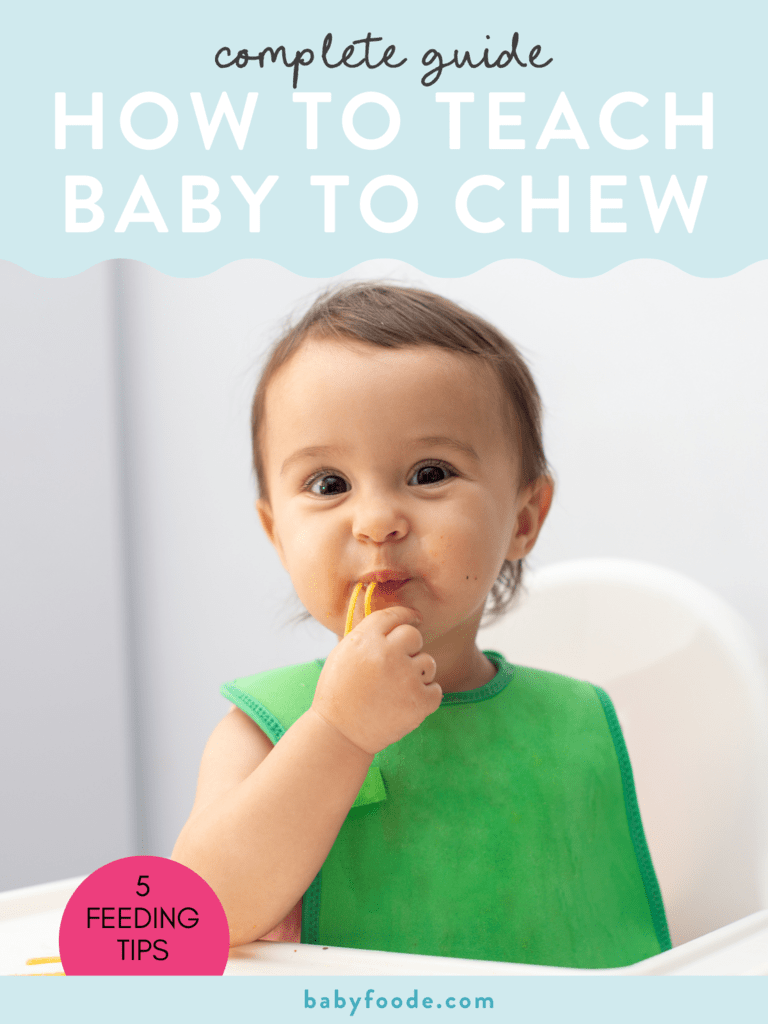How to Teach Baby to Chew
Helping your baby learn to chew is an exciting and important developmental milestone. We’ll discuss the background on how and when your baby learns to chew, as well as what to consider when teaching your baby to chew, and tips to get started.

Medically reviewed and co-written by Lauren Braaten, Pediatric Occupational Therapist (OT).
How does Baby Learn to Chew
Babies aren’t born with the chewing skills needed to eat a thick piece of steak. Learning to chew starts with a basic up and down jaw movement, called munching. This movement progresses over time, from diagonal chewing patterns, to circular chewing, and eventually into the most mature pattern, rotary chewing.
Throughout this process, babies are also developing side-to-side tongue movements, called tongue lateralization. Tongue lateralization helps push food over to the sides of the mouth, where the molars will later come in. As your baby chews, tongue lateralization is what helps form food into a little ball or “bolus,” which is eventually transferred to the back of the mouth for swallowing.
Some babies progress along this developmental process of learning to chew and swallow without much assistance, while other babies need a little more. It’s important to remember that eating is the most complex physical task that children do. A typically developing child will take about until 2 years of age to learn to eat a wide variety of foods.
When Should a Baby Start Chewing?
Babies typically start to mouth and chew on teethers, toys, and their hands between 4-6 months. However, it will likely be closer to 6-8 months that babies are truly ready to start practicing chewing soft solid foods.
What are the things to consider when teaching a baby to chew?
First, make sure baby is developmentally ready to chew – around 6 months of age, sitting with minimal assistance, good head control, able to pick up objects and bring hands to mouth, and appears interested in food.
Second, place your baby in a high chair that has good support for their trunk, hips, and feet. Good postural support helps with developing skills for chewing. Click here to read our guide on How to Find the Best Chair for For Baby.
Third, be aware of the size and textures of foods. Foods such as cooked vegetables or fruits should be soft enough to “squish” with gentle pressure between your thumb and index finger, but not so soft that they fall apart in your baby’s hand. Cut food into 2-3′ strips or sticks roughly the size of 2 adult fingers for babies 6-9 months. You can start to shred or serve food in smaller ‘pea’ sized pieces for babies 9-12 months.
Can babies chew without teeth?
Yes! Babies can definitely chew without teeth. Their gums can mash and grind most foods quite well. A baby’s molars don’t come in until after their first birthday, so if we waited to give baby chewable foods until then, your baby would miss months of valuable time to practice chewing.
Why does my baby not chew?
All babies are born with a reflex called the “tongue thrust” which helps move the tongue forward and backward to help with breast or bottle feeding. This reflex also helps the tongue push things like food forward and out of their mouths, to avoid choking.
The tongue-thrust reflex starts to integrate (or disappear) around 4-7 months of age, about the time that we start to offer baby practice with solid foods. In the beginning stages of this process, you might notice that baby spits out most of their food. This can happen when the food hasn’t been chewed enough or is too big to swallow. With continued practice, most babies will improve their skills and learn new patterns for moving food in their mouth.
In general, if your baby is not eating any solids (purees or soft finger foods) at 9 months or is only eating purees at 12 months of age, talk with your pediatrician about possible referrals to health care providers that can help.
Tips to Teach Baby to Chew
- Offer teething toys. Encourage baby to move them over to the biting surfaces. This helps with the up and down jaw movements and lateral movements of the tongue needed for chewing. Some favorite teething toys include the Baby Banana Toothbrush, the Comotomo Silicone Baby Teether and ARK’s Textured Grabber. You can also offer utensils such as the NumNum Gootensil or the ChooMee baby spoons as a teether and not just during feeding time.
- Start early toothbrushing habits. Massage baby’s gums with a clean washcloth and use a finger toothbrush or infant toothbrush to increase sensory awareness in the mouth (and for good oral hygiene!) We love the mushie baby finger toothbrush.
- Be a good role model. Sit down with baby at meal times, eat what they are eating, and exaggerate a little on how you are placing food in your own mouth, chewing, and swallowing. Yes, it might feel a little silly at first, but baby will love watching and learning from you, and want to try it too.
- Use appropriate finger foods. Try crackers or biscuits that melt easily, soft cooked veggies cut into strips or fruits that squish nicely, such as avocado or banana. Cutting foods into thin stick or strip shapes can help with placing foods on the sides for chewing.
- You can also use purees to support chewing skills. Purees help intrinsic tongue muscles develop, preparing your baby to chew and swallow more efficiently. If spoon feeding baby, you can alternate placing the spoon to the sides of the mouth as you would with a teether or soft piece of food. Just be sure to help your baby progress beyond only purees in a timely manner and onto more challenging textures of soft finger foods.

1 Comment on “How to Teach Baby to Chew”
How to teach baby to Chew was an very helpful article thanx…